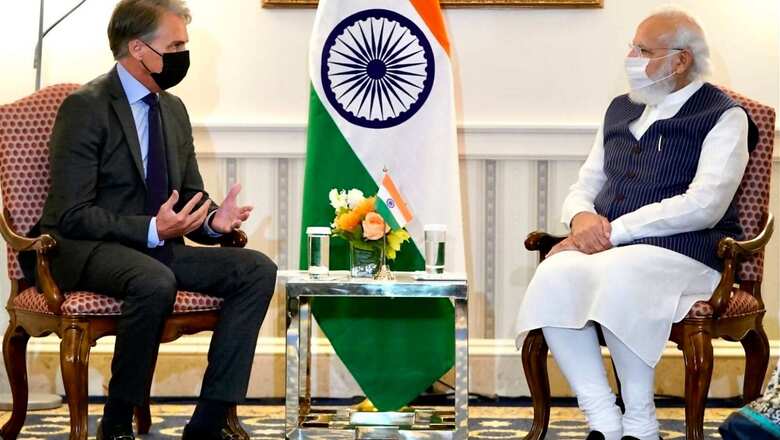
views
From Konark in the east to Modhera in the west, and from Anantnag’s Martand temple in the north to Suryanar Kovil, Kumbakonam, in the south, the Sun God has been part of Indian life from time immemorial. While sunlight has always been associated with health, energy and prosperity in common belief, it is only in the last few years that India has started to tap into literal solar energy.
Given India’s tropical geography, harnessing the power of sunrays for the country’s ever-growing energy requirements was always a no-brainer. The National Solar Mission launched in 2010 took the first steps towards formally tapping into naturally abundant solar energy. In the last few years, India has taken a place of prominence in this key component of a renewable power shift that’s underway globally.
At the Conference of Parties or COP21 in Paris in 2015, India outlined its Intended Nationally Determined Contributions (INDC) to achieve its broader carbon goals. India’s fourth INDC is dedicated to renewable power and it states: “To achieve about 40 per cent cumulative electric power installed capacity from non-fossil fuel-based energy resources by 2030 with the help of transfer of technology and low-cost international finance including from Green Climate Fund (GCF).”
From 2 gigawatts (GW) of installed capacity in 2014, India now has 44 GW of installed solar capacity. Although the near-term target of 100 GW has been impacted by two years of Covid-19 induced roadblocks, India has pledged to install 450 GW of renewable power by 2030. A substantial part of this target will be met via solar power.
That India attaches the highest importance to the growth of the solar sector was also underscored recently by Prime Minister Narendra Modi meeting Mark Widmar, CEO of First Solar, on his September trip to the United States, where the Quad leaders met. Widmar was one of only five CEOs with whom PM Modi interacted on this trip.
As the economy emerges from the shock of the pandemic, there have been encouraging developments, which indicate that there is renewed interest in India’s solar ambition and scaling. Both the government and the private sector efforts are coming together in this critical area and at the right time, just as the economic momentum picks up.
In April this year, the government approved the implementation of the production-linked incentive (PLI) scheme titled ‘National Programme on High-Efficiency Solar Photovoltaic (PV) Modules’. This PLI will aim to achieve the manufacturing capacity of GW scale in high-efficiency solar PV modules with an outlay of Rs 4,500 crore. As per media reports, nineteen companies had bid for this PLI across areas like manufacturing polysilicon, wafer and cells and modules. This represents the value chain for establishing solar plants.
Just this week, the government gave a go-ahead for an expression of interest for a 1 gigawatt-hour battery energy storage system as a pilot project. As the experience of countries that have a high mix of solar shows, energy storage is a critical part of maintaining a stable grid that feeds from solar power. Large-scale storage solutions will help in the greater adoption of solar power across the economy.
Coinciding with the policy push, India’s largest private-sector conglomerate Reliance recently invested $29 million as a strategic Series C lead investor in Germany-based NexWafe, a manufacturer of wafers for solar cells. Reliance has also recently acquired Norway-based REC Solar Holdings from China National Bluestar. These manufacturing investments indicate a shift in the private-sector approach to vertical integration in solar energy.
The fundraising and investing spree continues in enhancing renewable capacity otherwise. Reliance, in yet another investment, recently bought a 40% stake in Sterling & Wilson Solar, a Shapoorji Pallonji group company. Adani Green has acquired SB Energy in India’s largest renewables deal pegged at $3.5 billion. UK-based Actis, a large investor in the renewables space in India, is set to commit an additional $850 million to this sector over the next few years. Acme Power, a leading Indian solar firm, is investing in green hydrogen in a big way. ReNew Power recently became India’s largest publicly traded renewables company, listing on NASDAQ.
India has also recognised the importance of showcase projects powered by solar energy. The Puratchi Thalaivar Dr MG Ramachandran Central Railway Station in Chennai meets 100% of its day’s energy demand via solar power. Kochi Airport became the first airport globally to run exclusively on solar power a few years ago. Delhi Metro has been using solar power from a large solar plant in Rewa, Madhya Pradesh, for its operational as well as auxiliary power requirements.
Since 2019, India has been running the Pradhan Mantri-Kisan Urja Suraksha evam Utthan Mahabhiyan (PM-KUSUM) programme. This scheme aims to solarise the agricultural power requirement by promoting solar water pumps. The solarisation of agricultural feeders themselves is being tried by several states.
India has also taken the international lead in mainstreaming solar energy for better environmental outcomes and reducing fossil fuel dependency. The International Solar Alliance (ISA) is one of the two treaty-based international organisations based in India. Set up with joint sponsorship from France, the ISA is working on several initiatives to popularise and catalyse the adoption of solar energy globally. Today, 80 countries have signed and ratified the ISA framework agreement.
Given a facilitative policy environment and an ever-growing demand-side activity, it was a matter of time before the supply-side advancements happened on the manufacturing part of the solar energy landscape. With an ambitious solar power installation target, there’s a big local market to tap over the next decade. Additionally, India is also leading the way for global innovation and solar adoption push. India is well-positioned to become the global manufacturing hub of low-cost, high-energy solar panels.
Aashish Chandorkar is Counsellor at the Permanent Mission of India to the World Trade Organization, Geneva. The views expressed in this article are those of the author and do not represent the stand of this publication.
Read all the Latest News , Breaking News and IPL 2022 Live Updates here.















Comments
0 comment